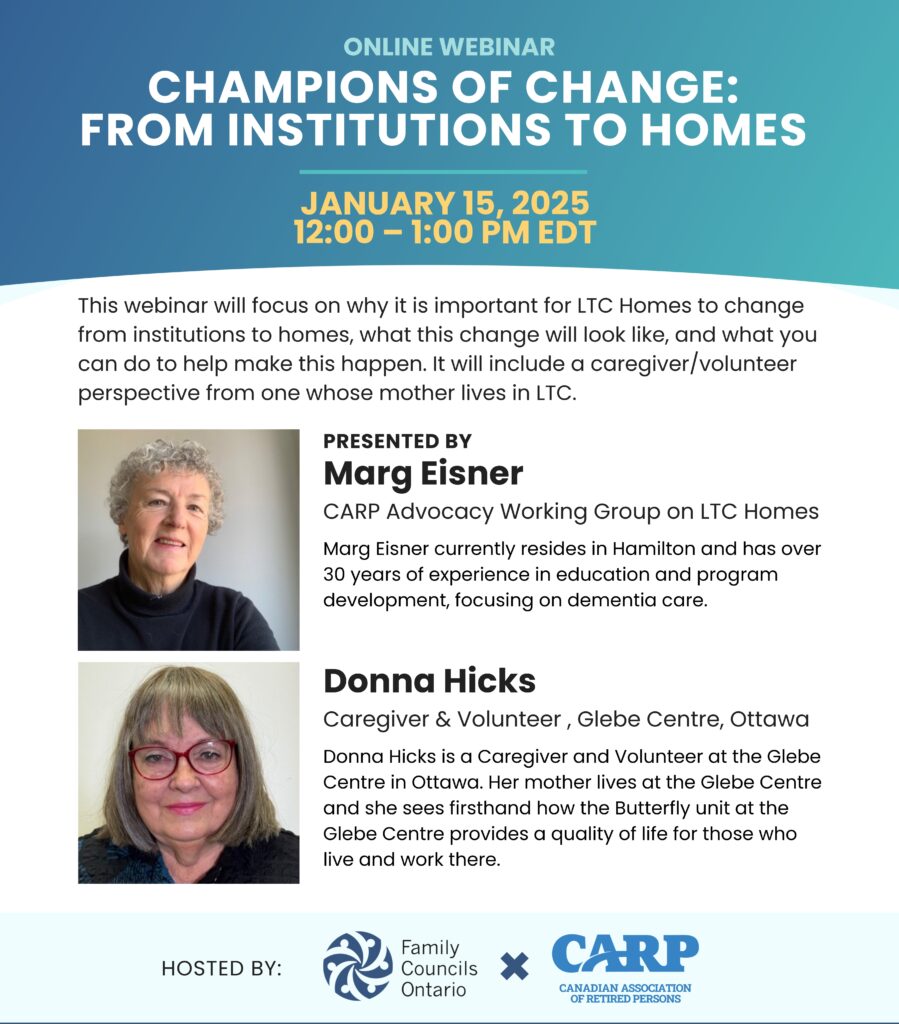This article was published in the Ottawa Citizen, May 4, 2022
C.A.R.P. asking for public support to make transformation of Ontario’s long-term care home system a ballot box issue
In a recent opinion piece Grace Welch and Brian Graham articulated well the major shortcomings of Ontario’s long-term care home system brought to light as a result of the pandemic and the type of changes needed.
Within the present system, it is very challenging for staff working in long-term care homes to address all the physical, social, psychological, spiritual, and cultural needs as described in the Long-Term Care Homes Residents’ Bill of Rights. Ontario has one of the most risk adverse long-term care homes system in Canada where the overabundance of regulations contributes to objectifying residents according to tasks, not needs.
C.A.R.P. – a New Vision for Aging (Canadian Association of Retired Persons) wants to see a drastic transformative change in long-term care homes from a task-based to an emotion-based model of care. Such models already exist: Eden Alternative, Green House, Butterfly and Hogewey in which the quality of care is understood as a relationship where residents, staff, families and volunteers are treated with dignity and respect in a homey environment, and kindness permeates the home. These models have been implemented in Canada including Ontario, Saskatchewan, Alberta, and British Columbia, in the United States, and internationally. No need to reinvent the wheel.
There are a growing number of both public and for-profit long-term care homes in Ontario that have successfully implemented an emotion-based model of care on one or more units in their homes. Most of these homes did so within existing budgetary and regulatory constraints with plans to expand the model.
Even closer to home, kudos to the Glebe Centre (a non-profit charitable home in Ottawa) which is already in the second stage of implementing the Butterfly model, and to Bonnechere Manor and Miramichi Lodge in Renfrew County which have begun the process of implementing the model.
These homes also experienced better outcomes both pre and during COVID than the traditional homes with fever cases and fewer deaths. Other benefits include improved resident and family engagement; improved staff satisfaction; reduced use of anti-psychotropic drugs; reduced use of food supplements; reduced staff sick leave (huge cost savings for some); and the list goes on.
We recognize that home care services are also broken and need a major revamping. However, our aging population is increasing and so is the number of people with dementia This means the need for long-term care homes is not going anywhere soon. Circumstances are such that not every loved one when becoming frail, either physically and/or cognitively, can be cared for at home. Approximately 85% of all residents in long-term care homes have either some kind of dementia or some complex chronic disease that requires 24/7 care. It is unrealistic to expect these individuals to be cared for at home.
The action needed is to immediately begin change from task-based to emotion-based care in Ontario’s long-term care homes. This can’t happen overnight but we need to start somewhere and the sooner we start the better. There are many ways to do so, including a variety of pilot projects – one unit at a time, one floor at a time, one home at a time. Residents in long-term care homes have been deprived for decades of the quality of care and quality of environment they so rightly deserve. This change can’t come quickly enough!
The Ontario Morocco Commission recommended ‘that the Government promote and provide funding for long-term care homes that change to recognized emotion-based models of care”. Ask your MPPs if they would commit to including this in the budget process in the first year of their term, if elected.
If we don’t begin to fix the long-term care home system now, after two years of horrific tragedies, long-term care homes will be forgotten once again for decades or until another pandemic hits!
Claude Paul Boivin, President, C.A.R.P. Ottawa
Kathy Wright, Vice-President, C.A.R.P. Ottawa
C.A.R.P. – A New Vision for Aging (formerly known as the Canadian Association for Retired Persons) is Canada’s largest advocacy Continue reading “C.A.R.P. asking for public support!”












